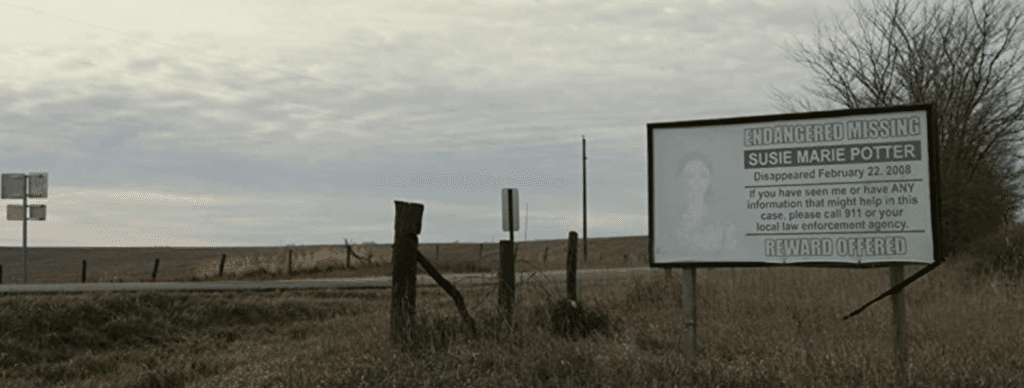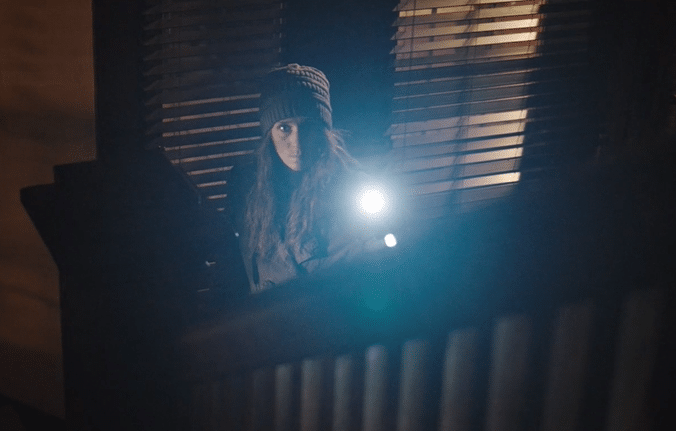
It’s a crime thriller, but Below The Fold starts with what could easily be a horror film opening. It’s an ominous take where it seems something sudden and shocking has happened: the TV is left on, showing nothing but dead air, a telephone receiver lies abandoned. What is this? We’re not told immediately – we’re not told anything immediately – but we cut to a slow news day in the press offices of Maryville, Missouri, where there’s some debate about covering a tractor pull competition. That gives us some sense of the relative peace and quiet here, but it turns out there might be a story worth covering. Turns out that, ten years previously, a young girl went missing in neighbouring Skidmore but the case went cold. Journalist David (Davis DeRock) gets the job of following it up, though it’s no tractor pull (the term ‘below the fold’ refers to stories printed in the bottom half of a newspaper page, and so automatically less visible, or deemed less interesting, to readers).
This is all complicated somewhat when a new reporter joins the team, and it is immediately apparent that David and new girl Lisa (Sarah McGuire) have some history. Nonetheless, she soon wants in on the Skidmore story, and so they go to speak to the missing girl’s sister – who explains that, age twelve, Susie went to the car to retrieve her Bible one evening and simply vanished into thin air. A later incident suggested that someone, likely the responsible party, was still watching the family: significant and annotated pages from the Bible were delivered to their home. And is someone watching the journalists, too? As they go on with their investigations, they meet a very tangled web of silence, proffered clues, red herrings and dead ends, but it seems that something sinister is at play here. Suggested links between Susie’s disappearance and the murder of another local girl complicate this picture further.
All of this unfolds slowly, and this is by no means a good choice of film for people into high action. Consider yourselves warned. The suspense here is doled out very carefully and steadily, and though some of the film’s initial drive subsides a little in the last thirty minutes or so, overall the pace is handled well; it’s in keeping with the tone and style overall. There are some genuinely unsettling scenes along the way, and the film is rich on mood. A lot of its success in this aspect stems from the strong camera work: there are no wasted or needlessly wheeling shots, and the edit is equally strong. Shots of rural decay in this neck of the woods – abandoned and tumbledown homes, beautiful but remote and barely-populated landscapes – makes some links to American Gothic with its own mysteries, isolation and secrets. The most frightening aspect of the film is in the horror of remote communities, but this comes across without resorting to caricature. It more focuses on what happens to people living this way when the threads that hold them together – Christianity, for example – begin to come apart? Linked to this is the question of when close-knit becomes constrictive; there’s certainly some class commentary in here, though, again, it’s kept on the downlow. Don’t expect acres of exposition, as that is left to the audience.
If the themes and motifs here have been seen elsewhere in other films, albeit perhaps looking a little different or playing out differently, then so be it. This is a good piece of filmmaking in any case, by a first-time feature director and writer, made on an indie budget with (I’m sure) all of the subsequent issues and hurdles to get past. Perhaps the biggest sticking point for viewers used to the kind of denouement they’re used to – even the kind that they demand – will come with the ending, and I’ll admit to a moment of real surprise myself at that point. It’ll be divisive. On reflection, I think it’s actually very brave, not to mention worldly – Below The Fold is a piece of fiction, but it comes with a reminder that life doesn’t follow any narrative rule book.
